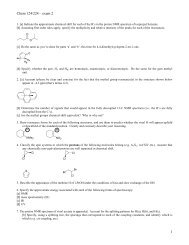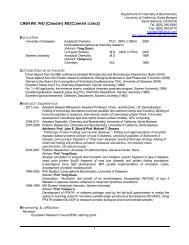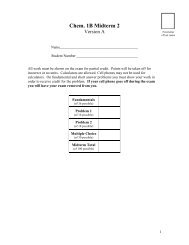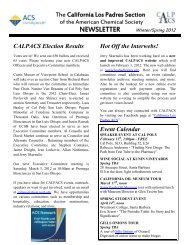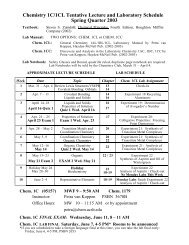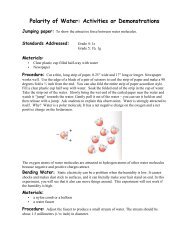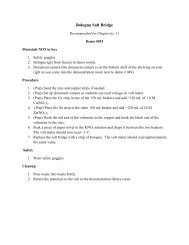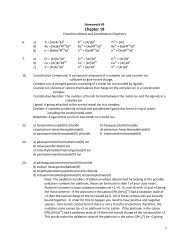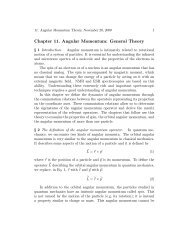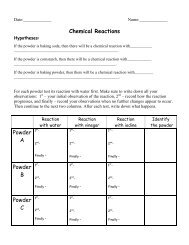Chemistry 1C Review Problems, Chapters 13, 14 and 16 ...
Chemistry 1C Review Problems, Chapters 13, 14 and 16 ...
Chemistry 1C Review Problems, Chapters 13, 14 and 16 ...
Create successful ePaper yourself
Turn your PDF publications into a flip-book with our unique Google optimized e-Paper software.
<strong>Chemistry</strong> <strong>1C</strong> <strong>Review</strong> <strong>Problems</strong>, <strong>Chapters</strong> <strong>13</strong>, <strong>14</strong> <strong>and</strong> <strong>16</strong> vanKoppen Spring 2002<br />
Exam 1: Friday, April 26 9 – 9:50 PM Chem. 1179<br />
In studying for the exam do homework problems, the quiz, examples in the text <strong>and</strong> in lecture again!!! Do the assigned<br />
problems <strong>and</strong> additional problems if needed. After you finish all the assigned problems, work the following review problems<br />
using one 8.5 x 11 inch page of notes which you are allowed to have during the exam (use only two thirds of one side of the<br />
page so you will have room for more notes for the second midterm <strong>and</strong> final).<br />
Check your quiz <strong>and</strong> exam scores on the web: http://www.chem.ucsb.edu/<br />
Go to Undergrads —> Course Web Pages –> Chem <strong>1C</strong>-<strong>1C</strong>L (Van Koppen) You will need to set up a new student account by<br />
entering your perm, a 4-digit pin <strong>and</strong> confirm the pin. Then use your perm <strong>and</strong> pin number to check your scores.<br />
Structure <strong>and</strong> Bonding<br />
Chemical bonds between metals <strong>and</strong> non-metals tend to be ionic. Metals tend to lose the number of electrons needed to attain<br />
a noble gas configuration <strong>and</strong> the non-metal atoms tend to gain the number of electrons needed to attain a noble gas<br />
configuration. e.g. Na + – Cl –<br />
Chemical bonds between non-metal atoms tend to be covalent. In covalent compounds, pairs of shared electrons make the<br />
bonds between the atoms. e.g. H – H<br />
Atom <strong>and</strong> ion size strongly influence bonding <strong>and</strong> chemistry:<br />
Covalent bonds: a smaller atomic radius => shorter bond distance => better orbital overlap => stronger bond<br />
Ionic bonds: a smaller ionic radius => shorter bond distance => greater V(r) => stronger bond<br />
NOTE: The Coulomb force of attraction = V(r) = Q 1 Q 2 /4πε o r, where Q 1 <strong>and</strong> Q 2 are the numerical charges on the ions<br />
<strong>and</strong> r is the distance between the centers of the ions. For Na + – Cl – , Q 1 = +1 Q 2 = –1, <strong>and</strong> r is the distance from the<br />
center of Na + to the center of Cl – (See text pg. 568).<br />
Cohesion of crystalline solids: Molecular, Ionic, Metallic <strong>and</strong> Covalent Crystals<br />
1) Molecular Crystals: Molecules are held together in their crystal lattice by intermolecular forces, including hydrogenbonding,<br />
dipole-dipole forces, or London Dispersion Forces (LDF). Intermolecular forces are generally weaker than those in<br />
ionic, metallic <strong>and</strong> covalent crystals. As a result, molecular crystals typically have low melting points, are soft, <strong>and</strong> have poor<br />
conductivity. Examples of molecular crystals include noble gases, oxygen, nitrogen, halogens, compounds such as CO 2 ,<br />
organic compounds, proteins, <strong>and</strong> metal halides with low ionicity.<br />
Molecular crystals are of great scientific value. If proteins <strong>and</strong> other macromolecules are obtained in the crystalline state,<br />
their structures can be determined by x-ray diffraction. Knowing the three-dimensional structures of biological molecules is<br />
the starting point for underst<strong>and</strong>ing their functions.<br />
2) Ionic Crystals: Compounds formed by atoms with significantly different electronegativities are ionic. e.g. NaCl, CsCl,<br />
ZnS, CaF 2 , etc. The strong <strong>and</strong> long range electrostatic forces make ionic crystals hard, high-melting, brittle solids that are<br />
electrical insulators. Melting an ionic crystal, however, disrupts the lattice <strong>and</strong> sets the ions free to move, <strong>and</strong> so ionic liquids<br />
are good electrical conductors.<br />
3) Metallic Crystals: The characteristic property of metals is their good conductivity of electricity <strong>and</strong> heat. How do metals<br />
conduct electricity <strong>and</strong> heat (see lecture notes <strong>and</strong> pg 745-6 text) What is the bonding in metallic crystals The valence<br />
electrons in a metal are delocalized in molecular orbitals that extend over the entire crystal. The “sea” of electrons in metals<br />
accounts for strong bonding <strong>and</strong> high boiling points. Metals have a large range in melting points (e.g. Gallium melts in your<br />
h<strong>and</strong> at 29.78 o C <strong>and</strong> Tungsten, the highest melting elemental metal, melts at 3410 o C). Note that Gallium, like most metals,<br />
does have a high boiling point, 2400 o C.<br />
4) Covalent Crystals: In covalent crystals atoms are linked by covalent bonds rather than by either the electrostatic<br />
attractions of molecular <strong>and</strong> ionic crystals or the sea of valence-electrons (“the glue”) in metals. Covalent crystals, also known<br />
as network atomic solids, have high melting <strong>and</strong> boiling points due to the strong covalent bonds between the atoms. They are<br />
typically hard <strong>and</strong> brittle. e.g. diamond, graphite, black <strong>and</strong> red phosphorous. Diamond is an insulator whereas graphite is an<br />
electrical conductor. Explain why. (see pg. 751).<br />
APPROACH TO PROBLEM SOLVING:<br />
When you are asked to rationalize or predict relative boiling points, melting points, heats of vaporization, surface tension, etc.,<br />
what is the first question you should ask yourself What are the INTERMOLECULAR FORCES Or what type of<br />
crystalline solid is this Metallic, Covalent, Ionic or Molecular<br />
The general trend in strength of intermolecular forces from strongest to weakest are:<br />
Ionic > Hydrogen–bonding > dipole – dipole > LDF (or v<strong>and</strong>erWaal forces)<br />
(H bound to N,O,F) (polar molecules) (induced dipole forces)<br />
Note: LDF is considered a weak force. However, for large molecules, with large surface areas, LDF can be quite large giving<br />
rise to relatively high boiling points. For example, a non-polar hydrocarbon, C 25 H 52 , is solid at room temperature. Its boiling<br />
point is 400 o C. Compare the intermolecular forces for C 25 H 52 <strong>and</strong> H 2 O.<br />
1
Problem: Predict the trend in boiling points for BF 3 , BCl 3 , BBr 3 , BI 3 In order to determine the intermolecular forces you must<br />
know the type of molecule. Is it covalent, polar-covalent or ionic For covalent molecules draw the Lewis structure <strong>and</strong><br />
determine if it is polar. The boron halides are all trigonal planar, non-polar molecules. So what is the intermolecular force<br />
LDF. How will LDF differ for BF 3 , BCl 3 , BBr 3 <strong>and</strong> BI 3 As the size of an atom or molecule increases, the polarizability<br />
increases <strong>and</strong> thus LDF increases. Now you can answer the question: because atom size increases down the group, F < Cl <<br />
Br < I, the LDF forces increase down the group, BF 3 < BCl 3 < BBr 3 < BI 3 <strong>and</strong> the boiling points will increase down the group,<br />
BF 3 < BCl 3 < BBr 3 < BI 3 . The boiling points are: BF 3 –101 o C, BCl 3 12 o C, BBr 3 91 o C, BI 3 210 o C. Quite a difference!<br />
<strong>Review</strong> <strong>Problems</strong><br />
1. Circle the formula that best fits each of the following descriptions:<br />
a) greatest electronegativity Al C Na N<br />
b) longest bond length HCl HF HI HBr<br />
c) largest ionic radius Mg 2+ F – Na + O 2–<br />
d) least polar bond C – O C – N O – H<br />
e) smallest atomic radius S Na Si Al<br />
2. Draw the Lewis structure for SeF 2 <strong>and</strong> PO 3– 3 , predict the molecular geometry, <strong>and</strong> if the molecule is polar indicate the<br />
direction of the net dipole.<br />
3.<br />
–<br />
a) Draw the Lewis structures for each of the following compounds. Nitrogen is the central atom in both NO 2 <strong>and</strong> NO – 3 .<br />
NO + –<br />
NO 2<br />
–<br />
NO 3<br />
b) Which one of the following has the longest NO bond length, NO + , NO – 2 , or NO – 3 <br />
c) Which one of the following has the shortest NO bond length, NO + , NO – 2 , or NO – 3 <br />
4. a) Using the molecular orbital model write the electronic configuration <strong>and</strong> bond order of N 2 <strong>and</strong> O 2 b) Are N 2 <strong>and</strong> O 2<br />
paramagnetic or diamagnetic What does it mean when a molecule is paramagnetic How can we observe the<br />
magnetism of a molecule experimentally c) Does N 2 or O 2 have a higher bond energy Why<br />
5. What is the hybridization of the carbon atoms in CH 2 =CH <strong>and</strong> CH 2 2=C=CH 2 For each of these molecules are all the<br />
atoms in the same plane<br />
6. For each of the following molecules, indicate the number of σ-bonds, π-bonds, the steric number for each of the C <strong>and</strong> N<br />
atoms <strong>and</strong> hybridization on each of the C <strong>and</strong> N atoms. What are the angles a, b, <strong>and</strong> c in each of the molecules<br />
H<br />
• O• •<br />
H C C C H<br />
••<br />
H O N O<br />
•<br />
••<br />
••<br />
H<br />
7. Which of the following bonds is least polar C – O Br – Br O – H H – F<br />
8. Order Rb, F <strong>and</strong> O in increasing electronegativity. Order Na, Si, Ne <strong>and</strong> Cl in increasing atomic radius.<br />
9. Indicate the number of σ-bonds <strong>and</strong> π–bonds in each of the following molecules. a) N 2 b) CO c) O 2<br />
2- 2-<br />
10. Draw the Lewis structure for CO 3 including resonance structures. Determine the hybridization on the carbon in CO 3 <strong>and</strong><br />
give the molecular geometry<br />
11. What is the hybridization on each of the carbons in butane, CH 3 CH 2 CH 2 CH 3 . Are all the carbon <strong>and</strong> hydrogen atoms in the<br />
same plane<br />
12. How many electrons are involved in the π-bonding in benzene, C 6 H 6 What is the hybridization on the carbon atoms Are<br />
all the carbon <strong>and</strong> hydrogen atoms in the same plane Why or why not<br />
<strong>13</strong>. Which one of the following molecules, C 2 H 2 , C 2 H 4 , <strong>and</strong> C 2 H 6 , has the shortest bond distance between the carbon bonds<br />
Why<br />
<strong>14</strong>. Write the electronic configuration using the molecular orbital model of the following species <strong>and</strong> determine which has the<br />
largest dissociation energy O 2 , O – 2 , O 2– 2+<br />
2 , O 2<br />
15. Write the electronic configuration <strong>and</strong> number of unpaired electrons for the following: O, Al 3+ , C, Se 2–<br />
<strong>16</strong>. a) Draw the Lewis structure for SF 6 . How many electrons does S share Is this consistent with the octet rule<br />
b) For SF 6 , valence shell expansion of S allows additional electrons to be accepted in which orbitals Is valence shell<br />
expansion observed for second row elements<br />
c) What is the hybridization of S in SF 6 <br />
17. Which elements most commonly form π-bonds<br />
18. Which has the highest boiling point, BF 3 , BCl 3 , BBr 3 , BI 3 Why<br />
19. What is the hybridization on carbon in O=C=O <br />
20. Why does hydrogen have such low boiling <strong>and</strong> melting points<br />
21. Highest boiling point. Explain. a) He, Ne, Ar, Kr, Xe b) NH 3 , PH 3 c) HF, HCl<br />
22. Predict the boiling point of H 2 O if H-bonding between water molecules did not occur (use Fig <strong>16</strong>.4 Pg. 732 text). Would<br />
water be a liquid at room temperature without H-bonding<br />
2– 2–<br />
23. Why can't carbon form a compound such as CCl 6 while tin can form SnCl 6 <br />
24. Why can carbon form π–bonds with carbon, nitrogen <strong>and</strong> oxygen while other group 4 elements, Si, Ge, Sn <strong>and</strong> Pb, cannot<br />
••<br />
2
25.<br />
–<br />
What is the hybridization of P in PF 6 <br />
26. Indicate the type of crystalline solid formed for each of the following substances.<br />
Graphite, S 8 (See text Pg. 872, Fig. 19.<strong>16</strong> a) Na, H 2 O, SiO 2 , CH 3 NH 2 , NH 4 Cl, white phosphorous, black phosphorous (See<br />
text, pg 866, Fig. 19.12).<br />
27. Indicate the molecular geometry, polarity, <strong>and</strong> most important (strongest) intermolecular force for each of<br />
the following substances. a) BF 3 b) SO 2 c) C 6 H 6 d) Cl 2 e) CH 3 OH f) HCl g) NH 3<br />
h.) CCl 4<br />
28. A substance does not conduct electricity in either the solid or the liquid state <strong>and</strong> is almost insoluble in water. It melts at<br />
53 o C <strong>and</strong> boils at 174 o C. These properties are characteristic of which one of the following crystalline solids: a) ionic<br />
b) metallic c) molecular d) covalent (atomic network)<br />
29. In the lab this week you worked with benzophenone <strong>and</strong> cyclohexanone. Given the structures below, explain why<br />
benzophenone, C <strong>13</strong> H 10 O, is a solid at room temperature <strong>and</strong> why cyclohexanone, C 6 H 10 O, is at liquid at room temperature.<br />
Are all the carbon, hydrogen <strong>and</strong> oxygen atoms in the same plane in benzophenone Are all carbon, hydrogen <strong>and</strong> oxygen<br />
atoms in the same plane in cyclohexanone<br />
O<br />
O<br />
benzophenone<br />
cyclohexanone<br />
30. The enthalpy of vaporization of water is 44 kJ/mol. On top of one of the peaks in Rocky Mountain National Park the<br />
pressure of the atmosphere is 0.75 atm. a) Determine the boiling point of water at this location. b) Will your food take<br />
more or less time to cook at this elevation<br />
31. Consider the phase diagram for CO 2 , with its triple point, T, as shown.<br />
a) What phases are present at point B<br />
b) Dry ice, CO 2 (s), is solid at P = 1 atm <strong>and</strong> T = – 100 o C.<br />
Starting at this point on the phase diagram, draw a line<br />
showing the phase transition(s) which occur as the<br />
temperature is increased from – 100 o C to 100 o C<br />
at constant pressure.<br />
c) According to the phase diagram, which phase is more<br />
dense, liquid or solid<br />
Pressure<br />
B•<br />
•<br />
T<br />
Temperature<br />
Solutions<br />
1. a) N b) HI c) O 2– d) C–N e) S<br />
2. Lewis structure molecular geometry polarity<br />
PO 3<br />
3–<br />
SeF 2<br />
3. a)<br />
b) NO 3 – . c) NO +<br />
4 a) N 2 : (σ 2s ) 2 (σ 2s<br />
*) 2 (π 2p ) 4 (σ 2p ) 2 Bond order = 3. O 2 : (σ 2s ) 2 (σ 2s<br />
*) 2 (σ 2p ) 2 (π 2p ) 4 (π 2p<br />
*) 2 Bond order = 2.<br />
b) N 2 is diamagnetic because is has no unpaired electrons <strong>and</strong> O 2 is paramagnetic because it has unpaired electrons.<br />
Paramagnetic molecules are attracted to a magnetic field. c) The bond order for N 2 is greater than for O 2 <strong>and</strong> therefore N 2<br />
has a greater bond energy.<br />
3
5. For CH 2 =CH both carbons are 2 sp2 hybridized <strong>and</strong> all the atoms are in the same plane. For CH 2 =C=CH 2 the two end<br />
carbons are sp 2 <strong>and</strong> the central carbon is sp hybridized. Not all atoms are in the same plane: the two CH 2 groups are in<br />
perpendicular planes.<br />
6. Molecule A: six σ-bonds, two π-bonds, the hybridization on the left carbon is sp 3 , the other two carbons are sp hybridized;<br />
angle a = 109 o , angle b = 180 o , angle c = 180 o Molecule B: four σ-bonds, one π-bond, the hybridization on the nitrogen<br />
is sp 2 ; angle a = 109 o , angle b = 120 o , angle c = 120 o<br />
7. Br 2 is least polar because it is non-polar.<br />
8. Electronegativity: Rb < O < F Atomic Radius: Ne < Cl < Si < Na Why <br />
9. a) N 2 has a triple bond; one σ-bond <strong>and</strong> two π-bonds. b) CO has a triple bond; one σ-bond <strong>and</strong> two π-bonds. c) O 2 has<br />
a double bond; one σ-bond <strong>and</strong> one π-bond.<br />
10. See problem 62, Chapter <strong>13</strong>.<br />
11 The carbons in butane are all sp 3 hybridized. The carbon <strong>and</strong> hydrogen atoms are not in the same plane. See Fig 22.4, pg.<br />
974. Can you see how all the dipoles in butane cancel <strong>and</strong> that butane is non-polar Most hydrocarbons are essentially<br />
non-polar.<br />
12. There are three π-bonds <strong>and</strong> therefore there are six π-electrons. The hybridization on the carbon atoms is sp 2 . All the<br />
carbon <strong>and</strong> hydrogen atoms are in the same plane because the sp 2 hybridization results in planar geometry. For<br />
resonance to occur the p-orbitals on neighboring carbon atoms must overlap which requires the molecule to be planar.<br />
<strong>13</strong>. C 2 H 2 has the shortest C–C bond because it is a triple bond whereas C 2 H 4 has a double bond <strong>and</strong> C 2 H 6 has a single bond.<br />
<strong>14</strong>. O 2 (σ 2s ) 2 (σ 2s<br />
*) 2 (σ 2p ) 2 (π 2p ) 4 (π 2p<br />
*) 2 Bond order = 2<br />
–<br />
O 2 (σ 2s ) 2 (σ 2s<br />
*) 2 (σ 2p ) 2 (π 2p ) 4 (π 2p<br />
*) 3 Bond order = 1.5<br />
2–<br />
O 2 (σ 2s ) 2 (σ 2s<br />
*) 2 (σ 2p ) 2 (π 2p ) 4 (π 2p<br />
*) 4 Bond order = 1<br />
2+<br />
O 2 (σ 2s ) 2 (σ 2s<br />
*) 2 (σ 2p ) 2 (π 2p ) 4 Bond order = 3 = largest => Largest dissociation energy<br />
15. O (1s) 2 (2s) 2 (2p) 4 Two unpaired electrons Al 3+ [Ne] or (1s) 2 (2s) 2 (2p) 6 No unpaired electrons<br />
C (1s) 2 (2s) 2 (2p) 2 Two unpaired electrons Se 2– [Kr] No unpaired electrons<br />
<strong>16</strong>. a) Octahedral geometry, sulfur shares 12 electrons. No it is not consistent with the octet rule. b) Sulfur accepts<br />
additional electrons in d-orbitals. Valence shell expansion is not observed for second row elements. Why not<br />
c) d 2 sp 3 hybridization on S.<br />
17. π-bonds are commonly observed for carbon, oxygen <strong>and</strong> nitrogen. It is less common for sulfur to <strong>and</strong> phosphorous to<br />
make π-bonds. Sulfur makes π-bonds with oxygen in SO 2 , but S is too big to make strong π-bonds with itself. This is<br />
why unlike O 2 (g), a stable gas at room temperature, S 2 (g) is not observed. Sulfur is a solid at room temperature, S 8 (s).<br />
18. BI 3 has the highest boiling point. These molecules are all covalent non-polar <strong>and</strong> therefore the larger the molecule, the<br />
more polarizable, the stronger the LDF. 19. sp<br />
20. H 2 has a low molar mass, it has only two electrons => low polarizability => weak LDF => low b.p.<br />
21. a) Xe is the largest in size, greatest LDF=> higher b.p b) NH 3 has a higher b.p. due to H-bonding c) HF has a higher<br />
b.p. due to H-bonding<br />
22. A straight line extrapolation, following the trend of other group members, H 2 Te, H 2 Se <strong>and</strong> H 2 S, gives a boiling point of<br />
H 2 O of approximately – 123 o C. Without H-bonding water would be a gas at room temperature <strong>and</strong> pressure.<br />
23. Carbon follows the octet rule, it is not able to exp<strong>and</strong> its valence shell. Sn can exp<strong>and</strong> its octet by putting electrons into<br />
d-orbitals.<br />
24. Carbon has a small enough atomic radius to allow for effective overlap between the p-orbitals. The other group 4<br />
elements are bigger <strong>and</strong> p-orbitals do not overlap effectively.<br />
25. d 2 sp 3<br />
26. Graphite (covalent network), S 8 (molecular), Na (metallic), H 2 O (molecular), SiO 2 (covalent network) CH 3 NH 2<br />
(molecular), NH 4 Cl (ionic), white phosphorous (P 4 (s) molecular), black phosphorous (covalent network).<br />
27. a) BF trigonal planar, non-polar, LDF b) SO 3 2 bent, polar, dipole-dipole c) C 6 H 6 planar, non-polar, LDF d) Cl 2<br />
linear, non-polar, LDF e) CH 3 OH tetrahedral, polar, H-bonding f) HCl linear, polar, dipole-dipole g)NH 3<br />
trigonal pyramid, polar, H-bonding h) CCl 4 non-polar, LDF 28. Molecular<br />
29. In order to answer this question, determine the hybridization on the carbon atoms. All the carbon atoms in<br />
benzophenone are sp 2 hybridized (trigonal planar geometry) <strong>and</strong> therefore all the carbon, hydrogen <strong>and</strong> oxygen atoms<br />
are in the same plane. The planar geormetry results in a maximum surface area of contact between the molecules <strong>and</strong><br />
gives rise to relatively large LDF forces. The CO bond is polar so there are some dipole-dipole forces as well but the<br />
LDF forces are dominant in benzophenone. In cyclohexanone, the carbon bound to the oxygen is sp 2 hybridized, the<br />
other 5 carbons are sp 3 hybridized. The molecule is therefor not planar. See Figure 22.6, Pg. 980. LDF forces are<br />
weaker <strong>and</strong> therefor cyclohexanone has a lower melting point <strong>and</strong> is a liquid at room temperature.<br />
30. T = 365 K = 92.6 o C. Watch units!!! 1 kJ = 1000 J <strong>and</strong> you must convert degrees Celcius to degrees Kelvin.<br />
31. a) At point B, solid <strong>and</strong> liquid CO 2 are in equilibrium. b) The horizontal line drawn is below the triple point <strong>and</strong><br />
shows that CO 2 (s) goes directly to a gas at P = 1 atm. c) Solid CO 2 is more dense than liquid CO 2 . You can see this<br />
from the slope of the solid-liquid line. Keeping T constant while increasing P, draw a straight vertical line, liquid CO 2<br />
will go to the more dense phase, solid CO 2 . Water is unusual in this respect, liquid water is more dense than ice. See<br />
Fig. <strong>16</strong>, Pg. 780 text. That is why ice floats on water.<br />
4




